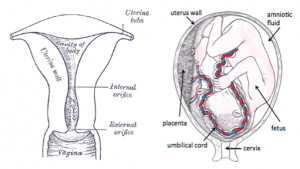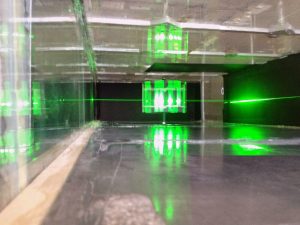The fluid dynamics of human birth
 We are interested in the roles that various fluids present in the pregnant uterus play during labor and delivery.
We are interested in the roles that various fluids present in the pregnant uterus play during labor and delivery.
We investigate (primarily experimentally) the fundamental physical processes during the final stage of labor and delivery, including the interaction between the pulsing uterus, amniotic fluid and fetus. Specifically, we are working to determine the role of amniotic fluid properties (i.e. viscosity, volume, pressure) in transferring the force of the contracting uterus to the fetus. Currently, nothing is known about the mechanical uses of amniotic fluid during labor. Additionally, we are establishing a relationship between the fetal lie (position in the uterus) and the force required to remove the fetus; furthermore, we can relate that to reasonable force limits that the fetus can experience should an assisted delivery be necessary—reducing fetal injury due to “tugging”.
Wake structures of vertical axis wind turbines (VAWTs)
 The purpose of this study is to measure the wake of a rotating airfoil as a model of a vertical axis wind turbine (VAWT).
The purpose of this study is to measure the wake of a rotating airfoil as a model of a vertical axis wind turbine (VAWT).
One component of our energy solution should be the integration of small-scale turbines in urban and suburban areas with high energy demands. Unlike very large horizontal axis wind turbines (HAWTs), moderately sized, and virtually silent, VAWTs can be placed in regions where land space is limited.
To date, many VAWT studies have assumed that the turbine has the same aero-dynamic structure as a spinning cylinder despite a signi cant increase in geometric complexity. This experiment attempts to understand the fundamental wake structure of a single VAWT (and compare it to the wake structure of a spinning cylinder). In this experiment, a scaled-down VAWT is placed inside a wind tunnel under a controlled laboratory setting. A motor rotates the scale model at a constant angular speed. Stereo particle image velocimetry (PIV) is used to visualize the wake of the turbine and image processing techniques are used to quantify the velocity and vorticity of the wake.
Unsteady propulsion (swimming)
Fundamentally, swimming is a transfer of momentum from a body to the fluid surrounding it. We investigate the unsteady mechanisms (tails, fins, flippers, feet) that produce aquatic propulsion.
We are investigating the hydrodynamics of pinniped swimming, specifically the California sea loin. Through our collaboration with the Smithsonian National Zoo–right here in Washington, DC–we collect observational data of swimming sea lions to extract their swimming kinematics. Once we understand how sea lions move through the water, we can investigate how the water reacts to them, leading to effective swimming.
